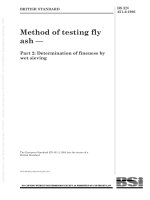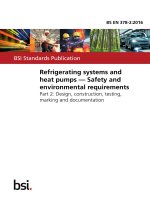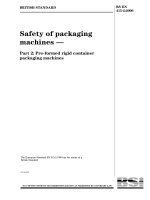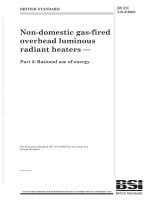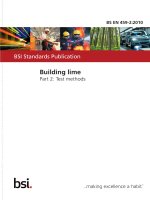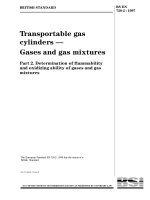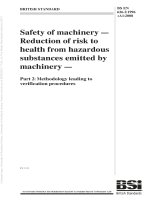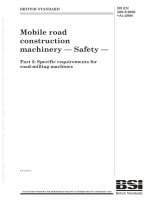Bsi bs en 50411 2 5 2009
Bạn đang xem bản rút gọn của tài liệu. Xem và tải ngay bản đầy đủ của tài liệu tại đây (1.78 MB, 50 trang )
BS EN 50411-2-5:2009
BSI British Standards
Fibre organisers and closures
to be used in optical fibre
communication systems —
Product specifications —
Part 2-5: Sealed closures for air blown fibre
microduct, type 1, for category S & A
NO COPYING WITHOUT BSI PERMISSION EXCEPT AS PERMITTED BY COPYRIGHT LAW
raising standards worldwide™
BRITISH STANDARD
BS EN 50411-2-5:2009
National foreword
This British Standard is the UK implementation of EN 50411-2-5:2009.
The UK participation in its preparation was entrusted by Technical Committee
GEL/86, Fibre optics, to Subcommittee GEL/86/2, Fibre optic interconnecting
devices and passive components.
A list of organizations represented on this committee can be obtained on
request to its secretary.
This publication does not purport to include all the necessary provisions of a
contract. Users are responsible for its correct application.
© BSI 2009
ISBN 978 0 580 64513 6
ICS 33.180.20
Compliance with a British Standard cannot confer immunity from
legal obligations.
This British Standard was published under the authority of the Standards
Policy and Strategy Committee on 31 July 2009
Amendments issued since publication
Amd. No.
Date
Text affected
BS EN 50411-2-5:2009
EUROPEAN STANDARD
EN 50411-2-5
NORME EUROPÉENNE
May 2009
EUROPÄISCHE NORM
ICS 33.180.20
English version
Fibre organisers and closures to be used
in optical fibre communication systems Product specifications Part 2-5: Sealed closures for air blown fibre microduct,
type 1, for category S & A
Organiseurs et btiers de fibres à utiliser
dans les systèmes de communication
par fibres optiques Spécifications de produits Partie 2-5: Btiers scellés
pour microconduits de fibres soufflées
à l'air comprimé, pour les catégories S & A
LWL-Spleißkassetten und -Muffen
für die Anwendung in LWLKommunikationssystemen Produktnormen Teil 2-5: Abgedichtete LWL-Muffen
für ABF-Mikrorohre, Bauart 1,
für die Kategorien S und A
This European Standard was approved by CENELEC on 2008-12-01. CENELEC members are bound to comply
with the CEN/CENELEC Internal Regulations which stipulate the conditions for giving this European Standard
the status of a national standard without any alteration.
Up-to-date lists and bibliographical references concerning such national standards may be obtained on
application to the Central Secretariat or to any CENELEC member.
This European Standard exists in three official versions (English, French, German). A version in any other
language made by translation under the responsibility of a CENELEC member into its own language and notified
to the Central Secretariat has the same status as the official versions.
CENELEC members are the national electrotechnical committees of Austria, Belgium, Bulgaria, Cyprus, the
Czech Republic, Denmark, Estonia, Finland, France, Germany, Greece, Hungary, Iceland, Ireland, Italy, Latvia,
Lithuania, Luxembourg, Malta, the Netherlands, Norway, Poland, Portugal, Romania, Slovakia, Slovenia, Spain,
Sweden, Switzerland and the United Kingdom.
CENELEC
European Committee for Electrotechnical Standardization
Comité Européen de Normalisation Electrotechnique
Europäisches Komitee für Elektrotechnische Normung
Central Secretariat: Avenue Marnix 17, B - 1000 Brussels
© 2009 CENELEC -
All rights of exploitation in any form and by any means reserved worldwide for CENELEC members.
Ref. No. EN 50411-2-5:2009 E
BS EN 50411-2-5:2009
EN 50411-2-5:2009
-2-
Foreword
This European Standard was prepared by the Technical Committee CENELEC TC 86BXA, Fibre optic
interconnect, passive and connectorised components.
The text of the draft was submitted to the formal vote and was approved by CENELEC as EN 50411-2-5 on
2008-12-01.
The following dates were fixed:
– latest date by which the EN has to be implemented
at national level by publication of an identical
national standard or by endorsement
(dop)
2009-12-01
– latest date by which the national standards conflicting
with the EN have to be withdrawn
(dow)
2011-12-01
__________
BS EN 50411-2-5:2009
-3-
EN 50411-2-5:2009
Fibre organisers and closures to be used in optical fibre communication systems –
Product specifications
Sealed closures for air blown fibre microduct, type 1, for category S & A
Description
Construction:
Cable management:
Cable seals:
Performance
Multiple ported closure
Microduct , protected microduct,
ducts and/or sub-ducts.
Heat activated and or cold applied
Applications:
Blown optical fibre cable
networks:
for underground:
for aerial:
EN 61753-1 Category S
EN 61753-1 Category A
Related documents:
EN 60793-2-50
Optical fibres – Part 2-50: Product specifications – Sectional specification for class B singlemode fibres (IEC 60793-2-50)
EN 60794-5
Optical fibre cables – Part 5: Sectional specification – Microduct cabling for installation by
blowing (IEC 60794-5)
EN 61300 series
Fibre optic interconnecting devices and passive components – Basic test and measurement
procedures (IEC 61300 series)
EN 61753-1
Fibre optic interconnecting devices and passive components performance standard – Part 1:
General and guidance for performance standards (IEC 61753-1)
EN 61756-1
Fibre optic interconnecting devices and passive components – Interface standard for fibre
management systems – Part 1: General and guidance (IEC 61756-1)
EN 61758-1
Fibre optic interconnecting devices and passive components – Interface standard for closures –
Part 1: General and guidance (IEC 61758-1)
ETSI EN 300 019 series Environmental Engineering (EE) – Environmental conditions and environmental tests for
telecommunications equipment
Duct and cable port entries and dimensions
(Direct burial or jointing pit mounted)
Construction:
Closure
www.bzfxw.com
Max sizes of
protected
microduct
cables
mm
Closure
designs
(Type and/or
sub-group)
Maximum
physical
dimensions in mm
Length L
Width W
Depth D
112
Type 1a
975 x 394 x 330
35
Type 2a
648 x 274 x 152
26
Type 2b
828 x 274 x 401
32
Single port
ends
300 x 200 x 100
50
Double port
ends
720 x 435 x 210
30
Rectangular
710 x 515 x 148
40
Circular
450 x 350 x 700
40
Elliptical
520 x 450 x 300
19
Type 1a
600 x 185 x 265
26
Type 1b
750 x 270 x 310
35
Type 1c
1 050 x 275 x 310
Pan closures
Dome closures
Single end entry
Tee closures
Central split access
Inline closures
Inline
(multiple
ports)
Tee
(single and
double port)
Pan
(circular or
rectangular)
Dome
(single end
entry)
BS EN 50411-2-5:2009
EN 50411-2-5:2009
-4-
Contents
1
Scope ......................................................................................................................................................... 7
1.1 Product definition .............................................................................................................................. 7
1.2 Operating environment ..................................................................................................................... 7
1.3 Reliability........................................................................................................................................... 7
1.4 Quality assurance ............................................................................................................................. 7
1.5 Allowed fibre and cable types ........................................................................................................... 7
1.6 Allowed microduct connector types .................................................................................................. 7
1.7 Microduct storage constraints ........................................................................................................... 7
2
Normative references ............................................................................................................................... 8
3
Definitions and abbreviations.................................................................................................................. 9
3.1 Definitions ......................................................................................................................................... 9
3.2 Abbreviations ..................................................................................................................................11
4
Description ..............................................................................................................................................11
4.1 Microduct closure ............................................................................................................................11
4.2 Closure housing functions ..............................................................................................................11
4.3 Burst pressure ................................................................................................................................11
4.4 Closure housing configurations ......................................................................................................12
4.5 Entry seals ......................................................................................................................................13
4.6 Common base configurations .........................................................................................................13
4.7 Microduct management system ......................................................................................................13
4.8 Materials .........................................................................................................................................14
4.9 Colour and marking ........................................................................................................................14
4.10 Microduct connectors applications and capacity ............................................................................14
5
Variants ....................................................................................................................................................15
6
Dimensional requirements .....................................................................................................................18
6.1 Dimensions of inline closures .........................................................................................................18
6.2 Dimensions of tee closures.............................................................................................................19
6.3 Dimensions of pan closures............................................................................................................20
6.4 Dimensions of dome closures.........................................................................................................21
7
Tests .........................................................................................................................................................22
7.1 Sample size ....................................................................................................................................22
7.2 Test sample preparation .................................................................................................................22
7.3 Test and measurement methods ....................................................................................................23
7.4 Test sequence ................................................................................................................................23
7.5 Pass/fail criteria ..............................................................................................................................23
8
Test report ...............................................................................................................................................24
9
Performance requirements ....................................................................................................................24
9.1 Dimensional and marking requirements .........................................................................................24
9.2 Sealing, optical and appearance performance criteria ...................................................................25
9.3 Mechanical sealing performance requirements ..............................................................................26
9.4 Environmental sealing performance requirements .........................................................................30
9.5 Mechanical optical performance requirements ...............................................................................32
9.6 Environmental optical performance requirements ..........................................................................33
Annex A (informative) Fibre for test sample details ....................................................................................34
Annex B (informative) Sample size and product sourcing requirements .................................................35
Annex C (informative) Closure minimum internal diameters, containing microduct connectors ..........36
www.bzfxw.com
BS EN 50411-2-5:2009
-5-
EN 50411-2-5:2009
Annex D (informative) Typical buried blown fibre microduct cable outside diameters ..........................41
Annex E (informative) Microduct connector definitions and sketches .....................................................42
Annex F (informative) Microduct minimum bend radius.............................................................................45
Bibliography ....................................................................................................................................................46
Figures
Figure 1 – Schematic – Minimum microduct and connector space profile (see Annex C) .............................. 11
Figure 2 – Inline – Double port ended (I) ......................................................................................................... 12
Figure 3 – ‘Tee’ – Single entry port ends with a single port at an acute angle................................................ 12
Figure 4 – ‘Tee’ – Double entry port ends with single or double ports at an acute angle ............................... 12
Figure 5 – Pan – Entry ports in one position at 90° to the circular cover removal axis ................................... 12
Figure 6 – Pan – Entry ports in one position at 90° to the rectangular cover removal axis ............................ 12
Figure 7 – Dome – Single end entry ported closure ........................................................................................ 13
Figure 8 – Diagram showing inline – Closures dimensions – Type 1 configuration ........................................ 18
Figure 9 – Diagram showing inline – Closures dimensions – Type 2a and 2b configurations ........................ 18
Figure 10 – Diagram showing tee – Closures dimensions showing single ports ............................................ 19
Figure 11 – Diagram showing tee – Closures dimensions showing double ports ........................................... 19
Figure 12 – Diagram showing pan – Circular or elliptical closures dimensions .............................................. 20
Figure 13 – Diagram showing pan – Rectangular closures dimensions ......................................................... 20
www.bzfxw.com
Figure 14 – Diagram showing dome – Circular and elliptical closures dimensions ........................................ 21
Figure 15 – Track joint configuration sample................................................................................................... 22
Figure 16 – Spur joint configuration sample .................................................................................................... 23
Figure 17 – Distribution joint configuration sample ......................................................................................... 23
Figure C.1 – Schematic – Minimum microduct and connector space profile .................................................. 36
Figure E.1 – Straight microduct connectors .................................................................................................... 42
Figure E.2 – Straight bulkhead microduct connectors ..................................................................................... 42
Figure E.3 – ID/OD/ID and OD reducer/enlarger stem microduct connectors ................................................ 42
Figure E.4 – ‘ID/OD/ID and OD reducer/enlarger’ microduct connectors ....................................................... 43
Figure E.5 – Close down microduct connectors .............................................................................................. 43
Figure E.6 – Liquid block microduct connectors .............................................................................................. 43
Figure E.7 – Liquid block with a barb end ....................................................................................................... 43
Figure E.8 – End stop microduct connectors .................................................................................................. 44
BS EN 50411-2-5:2009
EN 50411-2-5:2009
-6-
Tables
Table 1 – Variants for sealed closures for ABF protected microduct, for category S & A ............................... 15
Table 2 – Line closure capacity – Protected microduct cable selection – Maximum ...................................... 16
Table 3 – Tee closure capacity – Protected microduct cable selection – Maximum ....................................... 16
Table 4 – Pan closure capacity – Protected microduct cable selection – Maximum ...................................... 17
Table 5 – Closure capacity – Protected microduct cable selection – Maximum ............................................. 17
Table 6 – Dimensions of inline closures – Type 1, 2a and 2b configurations ................................................. 18
Table 7 – Dimensions of tee closures ............................................................................................................. 19
Table 8 – Dimensions of pan closures ............................................................................................................ 20
Table 9 – Dimensions of dome closures ......................................................................................................... 21
Table 10 – Tightness, optical and appearance performance criteria .............................................................. 25
Table 11 – Mechanical performance requirements ......................................................................................... 26
Table 12 – Environmental sealing performance requirements ........................................................................ 30
Table 13 – Mechanical optical performance requirements.............................................................................. 32
Table 14 – Environmental optical performance requirements ......................................................................... 33
Table A.1 – Fibre references ........................................................................................................................... 34
Table B.1 – Minimum sample size requirements ............................................................................................ 35
Table C.1 – Typical ABF closure minimum internal diameters, containing 2 blown fibre microduct
connectors ................................................................................................................................... 37
www.bzfxw.com
Table C.2 – Typical ABF closure minimum internal diameters, containing 4 blown fibre microduct
connectors ................................................................................................................................... 37
Table C.3 – Typical ABF closure minimum internal diameters, containing 7 blown fibre microduct
connectors ................................................................................................................................... 38
Table C.4 – Typical ABF closure minimum internal diameters, containing 8 blown fibre microduct
connectors ................................................................................................................................... 38
Table C.5 – Typical ABF closure minimum internal diameters, containing 9 blown fibre microduct
connectors ................................................................................................................................... 39
Table C.6 – Typical ABF closure minimum internal diameters, containing 12 blown fibre microduct
connectors ................................................................................................................................... 39
Table C.7 – Typical ABF closure minimum internal diameters, containing 19 blown fibre microduct
connectors ................................................................................................................................... 40
Table C.8 – Typical ABF closure minimum internal diameters, containing 24 blown fibre microduct
connectors ................................................................................................................................... 40
Table D.1 – Number of microducts per protected microduct – Direct bury ..................................................... 41
Table D.2 – Number of microducts per protected microduct – Direct bury reinforced .................................... 41
Table F.1 – Compilation of company standards, to arrive to an industry standard ......................................... 45
BS EN 50411-2-5:2009
-7-
EN 50411-2-5:2009
1 Scope
1.1 Product definition
This specification contains the initial, start of life dimensional, optical, mechanical and environmental
performance requirements which a fully installed blown fibre protected microduct closure must meet in order
for it to be categorised as an EN standard product.
These products are suitable for installation of and use with microduct fibre units, microduct optical fibre
cables, microduct and protected microduct as defined within EN 60794-5.
1.2 Operating environment
The tests selected combined with the severities and duration are representative of an outside plant for
subterranean and/or aerial environment defined by:
•
ETSI EN 300 019 series:
Class 8.1:
underground locations (without earthquake requirement);
•
EN 61753-1:
Category S:
Category A:
subterranean environment;
aerial environment.
1.3 Reliability
Whilst the anticipated service life expectancy of the product in this environment is a minimum of 20 years,
compliance with this specification does not guarantee the reliability of the product. This should be predicted
using a recognised reliability assessment programme.
1.4 Quality assurance
www.bzfxw.com
Compliance with this specification does not guarantee the manufacturing consistency of the product. This
should be maintained using a recognised quality assurance programme.
1.5 Allowed fibre and cable types
This closure standard covers all IEC standard optical fibre microducts, and protected microducts with their
various fibre capacities, types and designs. This includes, but is not limited to, optical fibre cable standard
EN 60794-5.
This product specification has only considered protected microduct cables containing microducts of same
outside diameters. There are other hybrid protected microduct cables with microducts of differing OD’s, with
too many variants to be included in this PS.
1.6 Allowed microduct connector types
This closure standard covers all EN standard microduct connectors, including: straight, reducer/enlarger
stem, reducer/enlarger, close down, liquid block, liquid block with barb end, and end stop connectors. This
includes, but is not limited to, EN 50411-2-8.
1.7 Microduct storage constraints
Microduct excess storage is not required in all air blown fibre closures. Some closure types do not have
sufficient internal space to provide storage. The need for microduct storage is provided inside the closure
when opened, typically to ensure that there is enough microduct to fulfil the following functions:
•
remove the coiled microduct attached to the ‘closedown’ connectors, to a remote location, close to
blowing equipment, in the process uncoiling the microducts to aid blowing;
•
provide additional microduct if repeated cut backs for connectors are planned or likely to be fitted
throughout the closure life.
The minimum microduct storage bend radius is based on the outside diameter and material selection,
typically based on 12 times the outside diameter (below 8 mm) and 20 times above. During fibre blowing the
bend radius is typically 20 times the microduct diameter.
BS EN 50411-2-5:2009
EN 50411-2-5:2009
-8-
2 Normative references
The following referenced documents are indispensable for the application of this document. For dated
references, only the edition cited applies. For undated references, the latest edition of the referenced
document (including any amendments) applies.
EN 50411-2-8
Fibre organisers and closures to be used in optical fibre communication systems –
Product specifications – Part 2-8: Microduct connectors, for air blown optical fibres,
Type 1
EN 60068-2-10
Environmental testing – Part 2-10: Tests – Test J and guidance: Mould growth
(IEC 60068-2-10)
EN 60794-1-2:2003
Optical fibre cables – Part 1-2: Generic specification – Basic optical cable test
procedures (IEC 60794-1-2:2003)
EN 60794-5
Optical fibre cables – Part 5: Sectional specification – Microduct cabling for
installation by blowing (IEC 60794-5)
EN 61300 series
Fibre optic interconnecting devices and passive components – Basic test and
measurement procedures (IEC 61300 series)
EN 61300-2-1
Fibre optic interconnecting devices and passive components – Basic test and
measurement procedures – Part 2-1: Tests – Vibration (sinusoidal) (IEC 61300-2-1)
EN 61300-2-4
Part 2-4: Tests – Fibre/cable retention (IEC 61300-2-4)
EN 61300-2-5
Part 2-5: Tests – Torsion/twist (IEC 61300-2-5)
EN 61300-2-10
Part 2-10: Tests – Crush resistance (IEC 61300-2-10)
EN 61300-2-12:2005
Part 2-12: Tests – Impact (IEC 61300-2-12:2005)
EN 61300-2-22
Part 2-22: Tests – Change of temperature (IEC 61300-2-22)
EN 61300-2-23:1997
Part 2-23: Tests – Sealing for non-pressurized closures of fibre optic devices
(IEC 61300-2-23:1995)
EN 61300-2-26
Part 2-26: Tests – Salt mist (IEC 61300-2-26)
EN 61300-2-33
Part 2-33: Tests – Assembly and disassembly of closures (IEC 61300-2-33)
EN 61300-2-34
Part 2-34: Tests – Resistance to solvents and contaminating fluids (IEC 61300-2-34)
EN 61300-2-37
Part 2-37: Tests – Cable bending for fibre optic closures (IEC 61300-2-37)
EN 61300-2-38:2006
Part 2-38: Tests – Sealing for pressurized fibre optic closures (IEC 61300-2-38:2006)
EN 61300-3-1
Part 3-1: Examinations and measurements – Visual examination (IEC 61300-3-1)
EN 61300-3-3:2003
Part 3-3: Examinations and measurements – Active monitoring of changes in
attenuation and return loss (IEC 61300-3-3:2003)
EN 61300-3-28
Part 3-28: Examinations and measurements – Transient loss (IEC 61300-3-28)
EN 61753-1
Fibre optic interconnecting devices and passive components performance standard –
Part 1: General and guidance for performance standards (IEC 61753-1)
www.bzfxw.com
ETSI EN 300 019 series Environmental Engineering (EE) – Environmental conditions and environmental tests
for telecommunications equipment
ISO 1998-1
Petroleum industry – Terminology – Part 1: Raw materials and products
EN 590
Automotive fuels – Diesel – Requirements and test methods
BS EN 50411-2-5:2009
-9-
EN 50411-2-5:2009
3 Definitions and abbreviations
3.1 Definitions
For the purposes of this document, the following terms and definitions apply.
3.1.1
ducts
semi-rigid underground pipe, typically manufactured from a polymeric material, and typically greater than
65 mm outside diameter
3.1.2
sub-ducts
underground semi-flexible pipes, which may fit inside a duct, typically manufactured from a polymeric
material, and typically less than 50 mm outside diameter
3.1.3
microducts (MD)
small, flexible, lightweight tube with an outer diameter typically less than or equal to 16 mm
3.1.4
protected microducts
one or more microducts surrounded by a protective sheath and/or protected by a duct/sub-duct
3.1.5
microduct optical fibre cables
optical fibre cables suitable for installation by blowing into a microduct
3.1.6
microduct fibre units
fibre unit that is suitable for installation by blowing into a microduct. It differs from microduct optical fibre
cables in that it provides less protection to the fibres that it contains
www.bzfxw.com
3.1.7
air blown fibre (ABF) microduct closure
ABF microduct closures provide a physical housing for microduct management; connection, fixing, sealing,
anchoring, liquid and/or gas blocking, storage and routing up to the input and output protected microduct of
the air blown fibre cable closure system
3.1.8
blowing point closure
closure used as a position for blowing fibre at multiple points in series (cascade blowing). Typically the
closure contains ‘close down’ microduct connectors, for fibre access to the blowing head equipment
3.1.9
straight microduct connectors
microduct connectors are used to connect two microducts together. This connector has a means of
microduct attachment and sealing on both sides and is typically unsupported (floating inside the closure)
3.1.10
straight bulkhead microduct connectors
microduct connectors are used to connect two microducts together. This connector has a means of
microduct attachment and sealing on both sides and is typically supported on a bulkhead attached by a
suitable fixing system (i.e. nut or clip)
3.1.11
different ID reducers/enlarger stem microduct connectors
stem connector which connects two microducts with the same OD but different ID, with a smooth internal
transition to prevent fibre hang ups. Typically they have microduct attachment and sealing at one end of the
connector, and a stem on the other end to facilitate attachment to a straight connector
3.1.12
different ID reducers/enlarger microduct connectors
connectors which connects two microducts with the same OD but different ID, including a smooth internal
transition to prevent fibre hang ups. Typically they are used to connect a heavy walled to a thinner wall MD
BS EN 50411-2-5:2009
EN 50411-2-5:2009
- 10 -
3.1.13
different OD reducers/enlarger stem microduct connectors
stem which connects two microducts with the same ID but different OD. Typically they have microduct
attachment and sealing at one end of the connector, and a stem on the other end to facilitate attachment to a
straight connector
3.1.14
different OD reducers/enlarger microduct connectors
connector which connects two microducts with the same ID, but different OD
3.1.15
different ID and OD reducers/enlarger stem microduct connectors
stem which connects two microducts with a different OD and different ID; including a smooth internal
transition to prevent fibre hang ups. Typically they have microduct attachment and sealing at one end of the
connector, and a stem on the other end to facilitate attachment to a straight connector
3.1.16
different ID and OD reducers/enlarger microduct connectors
connector which connects two microducts with different OD’s and different ID’s, including a smooth internal
transition to prevent fibre hang ups
3.1.17
close down microduct connectors
microduct connectors that are used for fibre access for blowing head equipment for cascade blowing,
allowing a microduct to be opened and resealed after blowing, without detriment to the fibre in situ
3.1.18
liquid block microduct connectors
microduct connectors that are used at a transition point to stop liquids from flowing between the connected
microducts to avoid liquid and contaminant ingress and liquid damage to other equipment
www.bzfxw.com
3.1.19
liquid block with a barb end
similar to a liquid block connector, at the barb end. The barb end is designed to interface with the nonmicroduct (transport tubing), which protects the fibre at a “fibre management system” closure
3.1.20
end stop microduct connectors
microduct connectors that are used for sealing open ended microduct, avoiding air leakage, water or foreign
material ingress
3.1.21
connector insertion force
force required to insert the microduct into the connector without damage
3.1.22
fibre management system (FMS)
system to control fibre routing from the incoming to the outgoing fibres, containing one or more splice
cassettes and additional functional elements
3.1.23
microduct management system
system to control microduct routing inside a closure or housing, from the incoming to the outgoing microduct,
all jointed together with microduct connectors of various functional types
3.1.24
burst pressure
point at which the closure fails to contain pressure
3.1.25
cut backs
process to remove a short length of microduct in order to prepare the ends, prior to fitting a new connector,
ensuring better sealing and attachment faces
BS EN 50411-2-5:2009
- 11 -
EN 50411-2-5:2009
3.2 Abbreviations
For the purposes of this document, the following abbreviations apply.
PS
Product Specification
MD
Microduct
ABF
Air Blown Fibre
ID
Inside Diameter (microducts)
OD
Outside Diameter (microducts)
AC
Across Corners
MMS
Microduct Management System
4 Description
4.1 Microduct closure
An ABF microduct closure comprises a closure housing that is attached to the ends of
•
an underground installed duct or sub duct or
•
an air blown fibre protected microduct.
Microduct closures comprises an access housing that allows the interconnection and storage of microducts
or protected microducts. Figure 1, shows the minimum space profile required to house microduct connectors.
www.bzfxw.com
Minimum space required as a diameter where microduct
connectors are equally spaced
Duct or cable attachment
V Diameter
(minimum)
W centred
(minimum)
(Inside cover diameter)
(Inside the cover body ends or end plates)
Figure 1 – Schematic – Minimum microduct and connector space profile (see Annex C)
4.2 Closure housing functions
Microduct closures for protected microducts have three basic functions they are to provide:
•
a branch off for secondary microduct installation to a customer;
•
an intercept to an existing pre-installed protected microduct;
•
an access point for blowing fibre onward using conventional blowing equipment.
4.3 Burst pressure
The microduct system may fail therefore the closure must be able to be fitted with an over pressure safety
system. This system should be able to exhaust air fast enough to ensure that a safe working pressure of
equal to, or less than 0,4 bars is maintained when the correct installation pressure is applied.
BS EN 50411-2-5:2009
EN 50411-2-5:2009
- 12 -
4.4 Closure housing configurations
4.4.1 Inline closure housing configurations (I)
Inline closures have cable entry ports in two positions at opposite ends. Each end typically has one or two
ports. Figure 2 shows a typical option for the ‘I’ closure type, any entry port can also be an exit port.
Figure 2 – Inline – Double port ended (I)
4.4.2 Tee closure housing configurations (T)
Tee closures have cable entry ports in three positions, one at each end and one at an acute angle, typically
at 90°. Each position typically has one or two ports. Figures 3 and 4 show typical options for the ‘T’ closure
type. This group also covers ‘Y’ closures at various angles.
Figure 3 – ‘Tee’ – Single entry port ends with a single port at an acute angle
www.bzfxw.com
Figure 4 – ‘Tee’ – Double entry port ends with single or double ports at an acute angle
4.4.3 Pan closure housing configuration (P)
Pan closures have cable entry ports in one position at 90° to the cover removal axis. They have typical three
or more ports. Figures 5 and 6 show typical options for the ‘P’ closure body types, typically circular, elliptic or
rectangular.
Figure 5 – Pan – Entry ports in one position at 90° to the circular cover removal axis
Figure 6 – Pan – Entry ports in one position at 90° to the rectangular cover removal axis
BS EN 50411-2-5:2009
- 13 -
EN 50411-2-5:2009
4.4.4 Dome closure housing configuration (D)
Dome closures have cable entry ports entering and exiting the same side, with high numbers of small cable
ports and low numbers of larger ports. Microduct storage is required over 180°. Figure 7 shows a typical
option for the ‘D’ closure type.
Figure 7 – Dome – Single end entry ported closure
4.5 Entry seals
Entry seal systems can be either:
-
-
-
(H) Dedicated heat activated heat source for example, electrical, infrared, hot air or flame
•
thermo-shrinkable materials,
•
hot melt adhesives,
•
polyethylene injection welding.
(C) Dedicated cold applied
•
mastic, tapes, pastes, potting compounds, gels and cold adhesives,
•
o-rings, grommets, rubber shapes, are cold processes.
www.bzfxw.com
(U) Combined heat activated and cold applied
All seals should be installed according to manufacturer’s guidelines.
4.6 Common base configurations
The design of the closure housing shall allow the jointing of two or more microducts, or protected microducts
in the following configuration or applications:
Track joint:
configuration used to connect two sub-ducts or protected microducts, with a minimum of
2 entry ports
Spur joint:
configuration used on local feeder cable with minimum of 3 cable entry ports
Distribution joint: configuration used on customer feed cable with minimum of 8 cable entry ports
NOTE Entry ports can accommodate more than one sub-duct or protected microduct.
The design of the distribution and spur closure housing shall allow the joining together of at least one pair of
cables which are not at the end of a cable section. This application is generally known as distribution,
external node or a mid-span closure.
It is desirable that the closure can be re-opened when necessary without interruption or disturbance of the
traffic of the live circuits within the microducts.
4.7 Microduct management system
The microduct management system consists of stored or routed microducts to EN 60794-5 and microduct
connectors to EN 50411-2-8. The system provides a means for routing, storing (if appropriate) and protecting
of microduct connectors or other passive optical devices (e.g. a blowing head) in a predetermined order.
A closure used as a blowing location requires storage of fibre microducts of a length suitable for remote
deployment to a blowing head.
BS EN 50411-2-5:2009
EN 50411-2-5:2009
- 14 -
4.8 Materials
All materials that are likely to come in contact with personnel shall meet appropriate health and safety
regulations. Materials must conform to ROHS requirements.
Closure and sealing materials shall be compatible with each other and with the materials of the cables.
All components of the closure shall be resistant to solvents and degreasing agents typically used.
The effects of fungus shall be determined by measuring a suitable property both before and after exposure
and tested according to EN 60068-2-10 (micro-organisms), using the 28-day test.
The effects of UV light shall not affect product performance for aerial closures. The use of UV stabilised
materials for the outer housing is required.
Metallic parts shall be resistant to the corrosive influences they may encounter during the lifetime of the
product.
4.9 Colour and marking
Marking/identification of the variant number (see Clause 5) should be on the product or packaging label
along with the following:
a)
identification of manufacturer;
b)
manufacturing date code: year / month.
4.10 Microduct connectors applications and capacity
www.bzfxw.com
The different types of microduct connectors can be found in EN 50411-2-8, ABF Microduct connectors for
non-sealed closures, this covers all applications and include the following connector types:
•
straight connector (see note);
•
straight bulkhead connector;
•
ID reduce/enlarger stem connector;
•
ID reduce/enlarger connector;
•
OD reduce/enlarger stem connector;
•
OD reduce/enlarger connector;
•
ID and OD reduce/enlarger stem connector;
•
ID and OD reduce/enlarger connector;
•
close down connector;
•
liquid block connector;
•
liquid block with a barb end connector;
•
end stop connector.
NOTE In order to reduce the number of variables, all connector volumes for any given closure size is based on the microduct outside
diameter with a standard size straight connector. The straight connector has been selected as it is the most widely used type.
BS EN 50411-2-5:2009
- 15 -
EN 50411-2-5:2009
5 Variants
Table 1 – Variants for sealed closures for ABF protected microduct, for category S & A
EN 50411-2-5 – X1 – X2 – X3 – X4 – XXX5 – XX6 – XX7 – XX8
Variant No. X1
Environmental performance
S
Subterranean environment (underground)
A
Aerial environment (above ground level)
B
Both subterranean and aerial
Variant No. X2
Operating environment
T
Track closure (2 cable entries minimum)
S
Spur closure (3 cable entries minimum)
D
Distribution closure (8 cable entries minimum)
Variant No. X3
Protected microduct sealing technology
R
Cold applied
H
Heat activated (heat source required)
U
Universal, both methods in a single cable entry base
Variant No. X4
Closure type, shape and port configuration
www.bzfxw.com
I
Inline – multiple port ends
T
Tee
P
Pan
C
Dome (all at the same end)
Variant No. XXX5
Microduct storage and fibre blow through
BNS
Fibre blow through with no storage
BWS
Fibre blow through and storage
BFS
Blow from (not through) but has storage
Variant No. XX6
Microduct outside diameter – Stored (straight connector only)
Outside diameter
03
3 mm
04
4 mm
05
5 mm
06
6 mm
07
7 mm
08
8 mm
10
10 mm
12
12 mm
14
14 mm
Depending on the primary protected microduct cable selection in Variant XX6 and XX7 (number of microducts
1, 2, 4, 7, 8, 9, 12, 19, 24 and 30 ) refer to one of the following Tables 2, 3, 4 and 5 to find X8.
BS EN 50411-2-5:2009
EN 50411-2-5:2009
- 16 -
Tables 2, 3, 4 and 5 are based on buried protected microduct cables.
Table 2 – Line closure capacity – Protected microduct cable selection – Maximum
XX6 Æ
Microduct O/D
03
04
05
06
07
08
10
12
14
Number of microducts in the protected microduct cable XX7
(number in box)
XX8 Closure
NA
19
7
7
4
2
1
NB
24
24
24
24
24
19
12
7
1
NC
24
24
24
24
24
24
19
19
1
ND
24
24
24
24
24
24
19
19
1
NE
24
24
24
24
24
24
19
19
1
NF
24
24
24
19
7
7
4
2
1
NG
24
19
7
4
4
4
2
1
1
NH
19
7
7
4
2
1
NJ
19
7
7
4
2
1
NK
19
7
7
4
2
1
NL
19
7
7
4
2
1
www.bzfxw.com
Table 3 – Tee closure capacity – Protected microduct cable selection – Maximum
XX6 Ỉ
Microduct O/D
03
04
05
06
07
08
10
14
Number of microducts in the protected microduct cable XX7
(number in box)
XX8 Closure
TA
24
12
7
4
4
2
1
TB
24
24
12
12
12
7
4
1
TC
24
24
24
12
12
12
7
1
TD
24
24
24
12
12
12
7
1
TE
24
24
24
12
12
19
7
1
TF
24
24
24
12
12
19
7
1
BS EN 50411-2-5:2009
- 17 -
EN 50411-2-5:2009
Table 4 – Pan closure capacity – Protected microduct cable selection – Maximum
XX6 Ỉ
Microduct O/D
03
04
05
06
07
08
10
14
Number of microducts in the protected microduct cable XX7
(number in box)
X8 Closure
PA
12
7
2
2
1
PB
24
12
7
4
4
2
1
1
PC
24
19
12
7
7
4
2
1
PD
24
19
12
12
12
4
2
1
PE
24
19
12
12
12
4
2
1
PF
24
19
12
12
12
4
2
1
PG
24
19
12
12
12
4
2
1
PH
24
19
12
12
12
4
2
1
www.bzfxw.com
Table 5 – Closure capacity – Protected microduct cable selection – Maximum
XX6 Ỉ
Microduct O/D
03
04
05
06
07
08
10
14
Number of microducts in the protected microduct cable XX7
(number in box)
X8 Closure
DA
12
7
2
2
2
1
DB
12
7
2
2
2
1
DC
24
12
7
4
4
2
1
1
DD
24
12
7
4
4
2
1
1
DE
24
24
19
7
7
7
4
1
DF
24
24
19
7
7
7
4
1
DG
24
24
19
7
7
7
4
1
DH
24
24
19
7
7
7
4
1
BS EN 50411-2-5:2009
EN 50411-2-5:2009
- 18 -
6 Dimensional requirements
6.1 Dimensions of inline closures
Maximum primary cable ports diameter D
P
E
F
Figure 8 – Diagram showing inline – Closures dimensions – Type 1 configuration
Maximum primary cable ports diameter D
P
F
E
www.bzfxw.com
Figure 9 – Diagram showing inline – Closures dimensions – Type 2a and 2b configurations
Table 6 – Dimensions of inline closures – Type 1, 2a and 2b configurations
Inline
closure
design type
Inline
closure
size
NA
NB
Type 1
Type 2a
NC
Maximum
overall
length
Maximum
overall
width
Maximum
overall
height
Maximum
cable
diameter
mm
mm
mm
mm
E
F
P
D
655
219
184
26
273
235
56
318
254
914
975
394
330
NE
914
318
305
112
NF
828
274
152
35
NG
648
160
150
28
NH
Type 2b
86
ND
NJ
119
557
216
NK
NL
287
401
828
274
254
26
BS EN 50411-2-5:2009
- 19 -
EN 50411-2-5:2009
6.2 Dimensions of tee closures
Maximum primary cable ports diameter D
F
E
P
(Alternative acute angle typically 45° to 60°)
Figure 10 – Diagram showing tee – Closures dimensions showing single ports
Maximum primary cable ports diameter D
F
www.bzfxw.com
E
P
Figure 11 – Diagram showing tee – Closures dimensions showing double ports
Table 7 – Dimensions of tee closures
Tee closure
design type /
Sub-group
Single port ends
Double port
ends
Tee
closure
size
Overall
length
Maximum
overall
width
Maximum
overall
height
Maximum
cable
diameter
mm
mm
mm
mm
E
F
P
D
TA
260
200
100
25
TB
300
160
70
32
TC
650
100
100
TD
720
435
210
TE
316
220
70
TF
560
210
180
40
50
BS EN 50411-2-5:2009
EN 50411-2-5:2009
- 20 -
6.3 Dimensions of pan closures
F1
P
F2
F1
E
F2
Maximum primary cable
ports diameter D
Figure 12 – Diagram showing pan – Circular or elliptical closures dimensions
P
F
E
www.bzfxw.com
Maximum primary cable ports diameter D
Figure 13 – Diagram showing pan – Rectangular closures dimensions
Table 8 – Dimensions of pan closures
Pan closure
size
Shape
sub-group
PA
PB
Rectangular
PC
Maximum
overall
length
Maximum
overall
diameter
Maximum
overall
diameter
Maximum
overall
height
Maximum
cable
diameter
mm
mm
mm
mm
mm
E
F1
F2
P
D
373
247
N/A
100
19
523
515
N/A
140
25
710
315
N/A
148
30
PD
250
PE
300
PF
Circular
450
350
395
400
PG
550
PH
700
PJ
PK
Elliptical
520
450
600
200
300
40
40
BS EN 50411-2-5:2009
- 21 -
EN 50411-2-5:2009
6.4 Dimensions of dome closures
F2
F2
F1
Maximum primary
cable ports
diameter D
F1
E
Figure 14 – Diagram showing dome – Circular and elliptical closures dimensions
www.bzfxw.com
Table 9 – Dimensions of dome closures
Dome closure
design type
Type 1a
Type 1b
Type 1c
Dome
closure size
DA
DB
DC
Maximum
overall length
Maximum
overall
diameter
Maximum
overall
diameter
Maximum cable
port diameter
mm
mm
mm
mm
E
F1
F2
D
185
265
19
270
312
26
275
310
35
505
600
DD
750
DE
540
DF
620
DG
800
DH
1 050
BS EN 50411-2-5:2009
EN 50411-2-5:2009
- 22 -
7 Tests
7.1 Sample size
Separate test samples for sealing performance and optical evaluation may be used. For the purposes of this
standard, a sealing performance test sample is defined as a closure installed with several cable ends.
Optical test samples shall be constructed as described in 7.2. Due to their complexity, consecutive testing on
the same optical sample is allowed. The minimum recommended sample sizes are given in Annex B.
7.2 Test sample preparation
7.2.1 Sealing performance test samples
Sealing performance test samples shall be provided with an air pressure test access valve. The length of the
protected microduct cables extending the closure shall be at least 1 m. The open ends of the microduct
cables shall be sealed. Each applicable cable type with minimum and maximum cable dimensions shall be
represented in the test program.
7.2.2 Optical test samples
Optical test samples shall be constructed in such a way that they will cover all allowed functions of a track
joint and/or distribution joint. The fibres for the optical test samples are covered in Annex A.
7.2.3 Optical test sample construction
Protected microduct cables should be sealed to the closure and the internal microducts separated and
routed inside the closure. Microducts are to be connected inside the closure using microduct connectors.
www.bzfxw.com
For the track joint closure (see Figure 15), the length of the test looped microduct cable is chosen in such a
way that it is longer than the dead zone of an OTDR. The required length depends on the selected pulse
width and dynamic range of the OTDR. Typically a cable loop length of 25 m to 50 m is chosen for this
purpose. Part of the test involves blowing the fibre bundle around the entire test circuit, from the test
equipment input to output position.
T ra c k jo in t
c o n fig u ra tio n
T e s t L o o p c irc u it
C o n n e c tio n s to
te s t e q u ip m e n t
In
O ut
1
2
3
4
1
2
3
4
Looped
c a b le
F ib re s
C lo s u re S a m p le in th e T E S T C h a m b e r
Tubes
T e s t c a b le
Figure 15 – Track joint configuration sample
In the track joint closure the fibres from one microduct cable end are connected to the fibres of the other
microduct cable end in such a way that light will sequentially flow through 4 selected fibres in the fibre
bundle. The first and the last fibre of this circuit will be spliced to the fibres of a drop cable for making
external connections to a light source and power meter.
BS EN 50411-2-5:2009
- 23 -
S pur
EN 50411-2-5:2009
c o n f ig u r a t io n
C o n n e c t io n s t o
t e s t e q u ip m e n t
C lo s u r e s a m p le in T E S T c h a m b e r
In
O ut
1
2
3
4
F ib r e s
Tubes
T e s t L o o p c ir c u it
1
2
3
4
S p u r/D ro p
T e s t c a b le
L e n g th L
Figure 16 – Spur joint configuration sample
Protected microduct cables should be sealed to the closure as stated in the track closure test sample. For
the track joint closure (see Figure 16), an active protected microduct drop cable will be installed in the spur
joint closure extending from at least one port.
D is t r ib u t io n
c o n f ig u r a t io n
T e s t L o o p c ir c u it
C o n n e c t io n s t o
t e s t e q u ip m e n t
C lo s u r e s a m p le in T E S T c h a m b e r
In
O ut
1
2
3
4
F ib r e s
Tubes
1
2
3
4
L e n g th L
D is t r ib u t io n / D r o p
T e s t c a b le
www.bzfxw.com
Figure 17 – Distribution joint configuration sample
Protected microduct cables should be sealed to the closure as stated in the track and spur closure test
samples for the distribution joint closure (see Figure 17).
Active microduct drop cables will be installed in the distribution joint closure extending from at least four
ports.
7.3 Test and measurement methods
All tests and measurements have been selected from EN 61300 series.
Unless otherwise stated in the individual test details, all attenuation measurements shall be performed at
(1 310 ± 25) nm, (1 550 ± 25) nm and (1 625 ± 25) nm for the environmental optical tests, and at (1 550 ± 25) nm
and (1 625 ± 25) nm for the mechanical optical tests.
All optical losses indicated are referenced to the initial attenuation at the start of the test. No deviation from
the specified test method is allowed.
7.4 Test sequence
There is no defined sequence in which tests 6 – 23 must be run.
7.5 Pass/fail criteria
A product will have met the requirements of this specification provided no failures occur in any test.
In the event of a failure occurring on a sealing performance test sample, the test shall be re run using a
sample size double that of the original.
Due to the complexity of the optical test samples, consecutive testing on the same optical sample is allowed.
In case of a failure during testing, a new sample shall be prepared and the failed test shall be redone.

